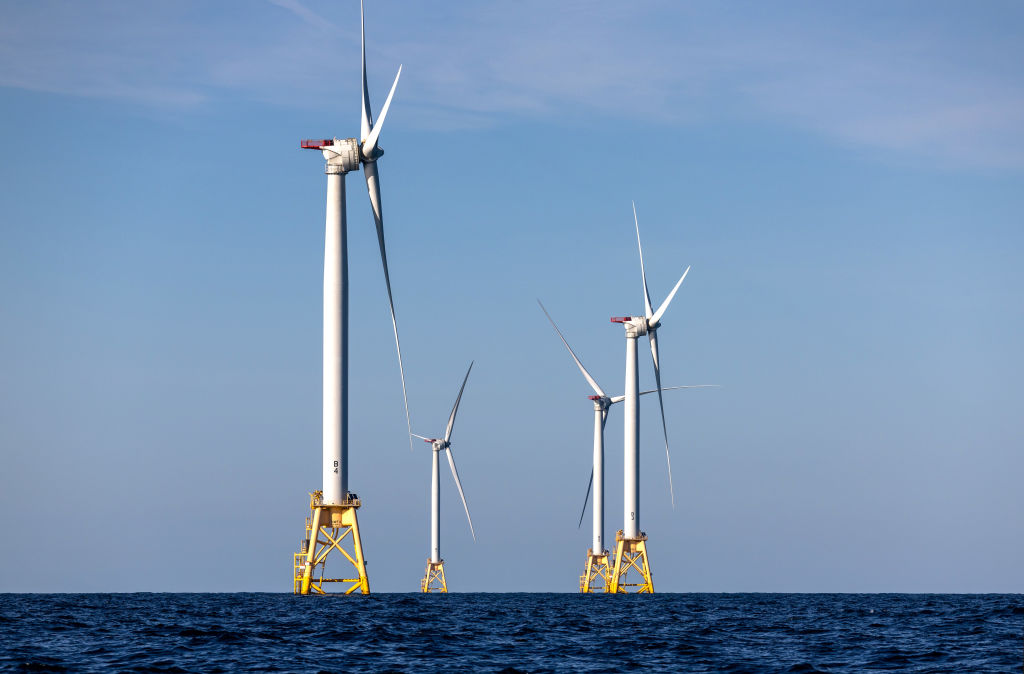Currently, six turbines off the coast of Rhode Island account for the lion’s share of the U.S.’s offshore wind energy production, providing 30 megawatts of electricity, or enough power to supply about 5% of the homes in one of the country’s smallest states. In less than three decades, though, researchers believe that massive offshore turbines could be producing more than 10,000 times as much energy, enough to supply up to a quarter of the country’s future electricity demand.
Those were the findings of a detailed new report from the University of California Berkeley, which concluded offshore wind could feasibly supply between 10% and 25% of the country’s energy demand by 2050, thanks to long coastlines with sustained winds in many areas, and falling turbine costs.
Currently, countries in Europe and Asia are far ahead in building turbines off their shores, with the U.S. only now getting started after decades of delay—the country’s first large-scale offshore wind farm started laying underwater foundations off the coast of Massachusetts in June. But the U.S. is almost certainly going to need more of its own offshore power.
Simply put, to decarbonize the U.S. economy by 2050, the renewable energy buildout will have to be enormous. Not only does the U.S. have to decarbonize its current electrical system, replacing the natural gas and coal plants that still account for about 60% of electricity nationwide, but the country also needs to build out vastly more renewable energy to replace gas powered cars and oil-burning boilers with electric vehicles and heat pumps.
Hypothetically, the U.S. could attempt to build out all that renewable energy on land, though the feat would be monumental. To supply all the energy the U.S. is likely to need in the coming decades, it’ll have to start building land-based wind farms and solar panels at about five times the rate compared to 2021, according to the report. That year was already a record-breaker, with the U.S. building out an enormous 28 gigawatts of solar and wind power. That’s roughly equivalent to the entire power plant capacity of Washington state. If the U.S. makes a big offshore wind push, however, things are likely to be somewhat easier: land-based renewables will only have to be built out at about three or four times the 2021 rate, according to the report.
But launching an explosion of offshore wind development is no simple task. There’s the fact of determined political opposition, often funded by the oil industry. And it’ll also require an array of federal, state, and local policies, as well as hundreds of billions of dollars in investment, according to the Berkeley researchers, who worked with climate think tanks GridLab and Energy Innovation on the report.
The Biden Administration has already set a goal to build 30 gigawatts of offshore wind power by 2030, but the U.S. government will have to scale that up to something resembling the goals in Europe if the sector is to have a shot of potentially supplying a quarter of the country's electricity. E.U. leaders are aiming to have 300 gigawatts of offshore wind power by 2050.
The push will also require a lot more state and federal bureaucrats. Permitting agencies will need more staff to cut down wait times for companies trying to develop new offshore wind sites, while agencies responsible for planning electrical transmission systems will need bigger budgets to start devising regional electrical systems that will be able to efficiently distribute the new power, according to the report (such pre-planning could save billions of dollars in electricity costs down the road). The U.S. will also need to expand workforce training programs, build up massive new supply chains, including huge new domestic steel plants, and build up port infrastructure to handle the task of bringing enormous turbine components out to sea.
Creating an entirely new clean energy industry is sure to have some notable benefits as well, even beyond helping stave off the worst effects of climate change. Such a buildout could, for instance, help create almost 390,000 jobs, according to the report authors’ estimates.
“The technical ability to build out America’s offshore wind sector and enjoy all the benefits of clean, reliable, affordable electricity is there,” Mike O’ Boyle, senior director of electricity policy at Energy Innovation said in a statement. “We just need political leadership to pass the right policies.”
More Must-Reads From TIME
- The 100 Most Influential People of 2024
- Coco Gauff Is Playing for Herself Now
- Scenes From Pro-Palestinian Encampments Across U.S. Universities
- 6 Compliments That Land Every Time
- If You're Dating Right Now , You're Brave: Column
- The AI That Could Heal a Divided Internet
- Fallout Is a Brilliant Model for the Future of Video Game Adaptations
- Want Weekly Recs on What to Watch, Read, and More? Sign Up for Worth Your Time
Write to Alejandro de la Garza at alejandro.delagarza@time.com
